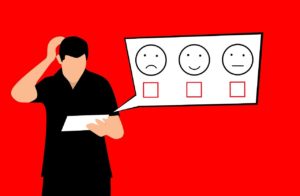TLDR: Do Your Customers Trust You?
(What is trust, how do you measure it, and why is it so important?)
Is your company doing better or worse in terms of maintaining and building customer Trust right now? Sadly most companies can’t even answer that question. Yet Customer Trust is a far more important metric than Customer Satisfaction, Net Promoter Score or any of the other measures CX/CS Professionals commonly track. In fact, our company has been offering a free service to monitor customer Trust since early April.
Trust is far more important than Satisfaction for several reasons which I’ll get into below. But before that, lets look at exactly what trust is, and how it can be measured accurately and consistently. Later this week I will be sharing ‘5 Tips on how your Customer Experience department can build customer trust right now’. However, before we start to work on improving Trust, I think it is important to understand just what it is, and why it is so important.
‘Trust’ in customer interactions – What is
“Trust”?
Emotions are an important area of study among psychologists. While there is disagreement about the significance and number of emotions most psychologists seem to agree on the 8 major emotions eloquently illustrated in Plutchik’s wheel of emotion.

The wheel attempts to juxtapose emotions so that they appear opposite each other in the wheel. As you can see, ‘Trust’ appears opposite ‘Disgust’ in the wheel. However, technically ‘Trust’ is different than most other emotions, as it consists in large parts of cognition related to experiences. For the purposes of this post though I will refer to customer ‘Trust’ as a general topic that can be measured in at least two ways, either as present or not present, as well as a more nuanced and valanced measure which can range somewhere between complete ‘Trust’ to complete ‘Distrust’ for a business/service.
We can rather accurately measure increases or decreases of trust among customers over time, or measure differences in trust between customer segments, specific product mentions, or between brands as a whole, as well as in terms of how various sales or customer service agents may be adding or detracting to the level of trust the customers they interact with have for your business.

How we think about Trust (in people, products and Brands)
Trust is made up of several parts.
Do you believe XYZ Corp can be trusted? Can Joe Smith be trusted? Either consciously or unconsciously we are evaluating whether individuals and organizations are trustworthy every day. Are they honest, are they fair, are they acting with our interests in mind, are they benevolent? Competence also plays a role, i.e. confidence is a type of trust. Confidence in the product/service that it will be reliable and work as expected.
Trust can be easily influenced by memory, both by prior experiences as well as what you have heard from others or on the news. Trust does not change as quickly as other emotions. Someone can go from satisfied to dissatisfied in an instant. Of course, there can be an immediate reaction with trust, but because trust involves cognition, we will evaluate it, and so even if something bad happens to you as a customer in a situation, your trust can still be recovered.
As trust is more complex than other emotions, it is harder to measure at one point in time at the individual level. It is something that tends to be in flux, either helped or eroded over time. It will be slightly influenced on the emotional side, but there will be a lot of thought processes involved trying to find reasons why a product is trustworthy or not.
At the individual level, trust is even tied to personality types, as it develops as thoughts and feelings that people have. For instance, during early stages of child development (birth to 3 years), if care is reliably available when needed, then these humans are more likely to trust others and have stable relationships. Without going into detail, we can extrapolate to the fact that some people are more trusting than others… And while there are more detailed segments of the population in psychology (technically 4 levels), we can generalize to just two segments, the larger group consisting of most people (60-70%) who are more secure in terms of trust, and the rest who are more distrustful naturally. Whether we tend to be naturally more or less trustful, trust is a critical part in any business relationship.
Measuring Trust

The good news is in business we can be less worried about the individual personality types and can more easily and quickly focus on trust in ways that can improve communication across our customer touchpoints. While trust can be measured in survey Likert scale ratings, measuring trust in verbal or written communication is in many ways more practical, and has a long history in the field of psychology.
At OdinAnswers we have been measuring ‘Trust’ in customer comments coming from various touch points for quite some time. Importantly, we’re not talking about just explicit mentions of trust such as “I trust your company completely”. While explicit mentions of trust like these are absolutely included in our models of Trust, the far larger component is made up of other more nuanced and tacit exclamations that serve as signals identifying Trust. Thus our validated ontology considers use of topics ranging from ‘Accuracy’ to ‘Virtuousness’, their synonyms and inflections, as well as more recent terminology like ‘alt right/left’ and ‘fake news’, as well as their contextual use in terms of whether or not they are negated. In the end, used correctly, this provides a much more flexible and powerful measure of trust than any Likert scale ratings, as it allows us to continuously scan customer communication, reading ‘between the lines’ for increases or decreases, and even in context to specific business issues.

So What? Earning and Keeping Customer Trust – The Customer Experience
Whether they know it or not, most companies are relatively good at ‘Trust’. Perhaps implicitly we all know how important it is as a first step in convincing a customer to even consider doing business with us. Yet it is important enough to consider explicitly, and companies that do so are much better for it.
If we think about it, it is a bit surprising how good some companies are in their solutions that either fix customer problems or avoid them proactively. Take stores that due to COVID-19 have been allowing returns for 6 months rather than 30 days. Instead of penalizing people during this critical time, they are helping them. Maybe customers do not want to go to post office for the next several weeks. When you see a company helping you your belief that they are fair and competent is increased. Trust increases.
Take travel and hospitality as another example, some airlines are allowing people to cancel and change flights without fees, even though this was not mandated. Instead it is something that was started for the customers benefit so instead of increasing stress it decreases it. Decreasing friction, increasing trust, leads to purchases.
Simply sharing information with your customers, explaining to them that you understand their needs, that you are doing something new, changing policies to help customers, if executed correctly, and monitored using natural language processing (text analytics) you should easily be able to link to and see how these changes in policy lead to positive changes in trust.
Take an even more common example of grocery stores during the past several weeks. Posting government safety notices, encouraging masks, tape measurement to maintain 6 foot distancing, allowing x number of customers in at a time. In aggregate these changes tell customers that the store is trying to be responsible, is capable, and the net is a positive trust builder on both a conscious and subconscious level. If measured, changes like these will be reflected in your customers minds and feedback comments and can be measured directly through text analytics, and ultimately in revenue as well as the even more valuable long term loyalty.
Just the fact that a business is open and continues to serve customers in whatever way they are able to during a crisis serves to increase trust. For those of us managing via Customer Satisfaction or Net Promoter Score, you can expect trust to be highly correlated with satisfaction and NPS.
In terms of customer service/support you will find that people are more forgiving as a sign of gratitude. Appreciation is a component in our trust ontology. Customers think “you are not abandoning us in this difficult time”. Even though rationally each business wants to stay open for its own egotistic reasons, it is still perceived very positively due to the contrast with other businesses which are closed. Thus, those businesses that do stay open are appreciated for it.
People are more likely to do good things and care about people (and businesses) than they normally would during crisis times like these (see my post which referenced September 11). While we can initially generate gratitude and Trust by simply remaining open in times like these, there is so much more we can do.

Importance of Trust – More important than Customer Satisfaction!
Trust is closely related to long term relationships and commitment. So, it is a critical part of long-term loyalty and repurchase. Satisfaction, is far more volatile. You may be disappointed in terms of satisfaction and continue a relationship (business). This is why Trust is so much more important than satisfaction (though the two are of course related), and should therefore be measured, tracked and understood. A customer can always be made happy again, but without Trust, the relationship ends. You will not get another chance.
Thanks for taking the time to follow me on just one of the many important customer dimensions that can be tracked and measured in customer communications. As mentioned, Trust really is more important than Customer Satisfaction or Net Promoter Score as it is not something ephemeral. It is lasting, and something that can be built up over time.
Check back Thursday for my next post ‘5 Tips on how to build Trust’ with your customers during this current time of crisis.
In the meantime I welcome your comments or questions below. If you would like more information on how OdinAnswers can help you understand Trust and other key issues in your customer communication and feedback feel free to contact us here.
@TomHCAnderson
Chief Research Officer
OdinAnswers
[NOTE: This post originated from a conversation I had with Lenny Murphy of The Greenbook who was interested in the free for COVID Customer Health Monitor. He pointed out how important one of our tracking themes ‘Trust’ is for many brands he has been speaking to. While my training is not in psychology, OdinAnswer’s ontology for trust and other key emotions in text data was implemented and continues to be honed by PhD’s in Psychology, and I consulted with one of our lead data scientists and PhD in Psychology, Dr Gosia Kolling before writing this post.]
Tom Anderson yes, agree. A little bit mixing apples and oranges here, as #Trust is a broader concept than NPS or CSAT. To me Trust is a mental shortcut for human decision-making that accrues to certain entities based on learning, while NPS and CSAT are very specific survey metrics. Never the less, agree that real Trust is much more powerful than the abstract measures called NPS and CSAT.
If we abstract the intent of NPS to be roughly equivalent to the concept of Trust, say NPS👉Advocacy, then I would say they are equally important attributes of brands. While it is likely that Trust enables Advocacy, which then engenders further Trust in a kind of virtuous circle, they are not equivalent. Trust clearly positions a brand to easily be selected in fast, system 1 decision making likes takes place for many everyday things. Advocacy is arguably the strongest possible driver of initial brand choice, so also plays a key role in brands being chosen and used. Net, both concepts are more important than the abstract measures.
I like your emotional character and intensity model👍. Though different in origin and character, Trust as a motivator of behavior can co-exist with emotions.
Thanks again, and all the best!
Robb
Trust is usually associated with organizations as brands (vs. products) and when present it adds considerable brand equity. A trustworthy or organization will be trusted and believed when it makes claims about their products and services. It supports credibility about an organization caring for its customers’ needs. Customers are more likely to forgive bad experiences, if not too frequent or intense, from trusted brands as organizations.
It’s less transactional in customers’ minds, but at the same time, it is built based on cumulative customer experiences through a myriad of transactions and touchpoints with different parts of the organization, including product user experience, customer service, support, sales promotions, etc. It is one of the underlying dimensions that can drive CSAT and NPS.
When present, it is often expressed through high levels of satisfaction and advocacy, even if it is not the only driver behind these metrics. It is a more complex construct worth measuring. Make sure to operationalize its measurement from the customers’ perspective. Otherwise, it becomes a very fuzzy concept and hard to work with if improvements are needed. Text analytics can help understand what it means for your organization.
Another great article, Tom.
Trust is definitely a component of customer satisfaction, as is relevance and utility. If your customer/constituent have ongoing negative experiences – even though “improvements have been made,” trust and value are dimished.
People need to perceive greater value and trust in your products/services – now more than ever. Yet, some companies/organizations hang their hat exclusively on NPS/CSAT metrics – and panic when they erode. Additional diagnostics, like assessing trust, relevance, etc. can help get to the “whys.”
Not wanting to be cynical, but does make me think of two things: 1) How do we determine which independent variable (predictor) is best unless we can agree on the optimum dependent variable (what we are trying to predict)? 2) Suspect many of the prime indepdent variable candidates (e.g., recommendation, loyalty, trust) are very highly correlated, at least that is what I empirically discovered, so does it really matter which we choose? Is a NPS really different from a NTS? Either way, I’d focus on the trend more than the score, unless one is considering a new employer.
@Patric You don’t need to choose of course. I agree, the trend is critical, and this approach allows you to monitor that. We shared real data from a real client who allowed us to share it on trust changing due to COVID in a previous post here: https://odinanswers.com/five-key-customer-signals-to-track-through-the-covid-19-crisis/
Again, I maintain the correlation between measures such qs trust, loyalty and recommendation is extremely high, Lose one and you are losing the others. Loyalty can be an outlier if a buyer “loves” a company but their company policy prohibits doing business with that seller, But, from a B2C perspective, that is very rarely pertinent. Juts my POV. Thanks for sharing the real data,
@Patrick RE your fist question. That is an interesting one. We can predict all sorts of things. But, I’m not even really sure we have to in this case. If a company breaks trust with enough of its customers, never mind the increased churn right there, it will have impact on WOM and brand that will hurt them even more, yet be rather difficult to measure in any MRX modeling. From a psychological position, its more or less undisputed, that one is more important than the other, as I discussed
RE second question, I know CSAT/OSAT and NPS correlation is super high, have measured that many times. The thing with CSAT and NPS is we can measure it for everyone all the time, whether through an actual rating or via their text comments (the latter is what I’m focusing on here). But Trust on the other hand, either overall, or valenced (either positive or negative), is not present in every comment for every customer. We have other attributes we measure like meeting expectations or not, and exceeding expectations is highly related to the emotion of surprise, which tends to be very positive. So while yes, I’m sure there are overlaps to varying degrees, this ‘Trust’ I am talking about is a bit more explicit, not always present, but when it is, it’s more cognitive and it can be measured, identified and understood in the context it comes up in. e.g. if it comes up significantly more often together with ‘Price’ for instance, it could mean that your pricing is unclear for instance.
@Robb, Thanks for your comment. Agree Trust is broader. But the fact is, today we can measure and track Trust about as easily as CSAT or NPS. In fact, we also have a text based NPS classifier that predicts NPS without asking it in customer comments
@Jeffrey, Thank you. The nice thing is also that it can now be measured so easily, and quickly (in real-time), and trended so we know if something is happening that affects it.